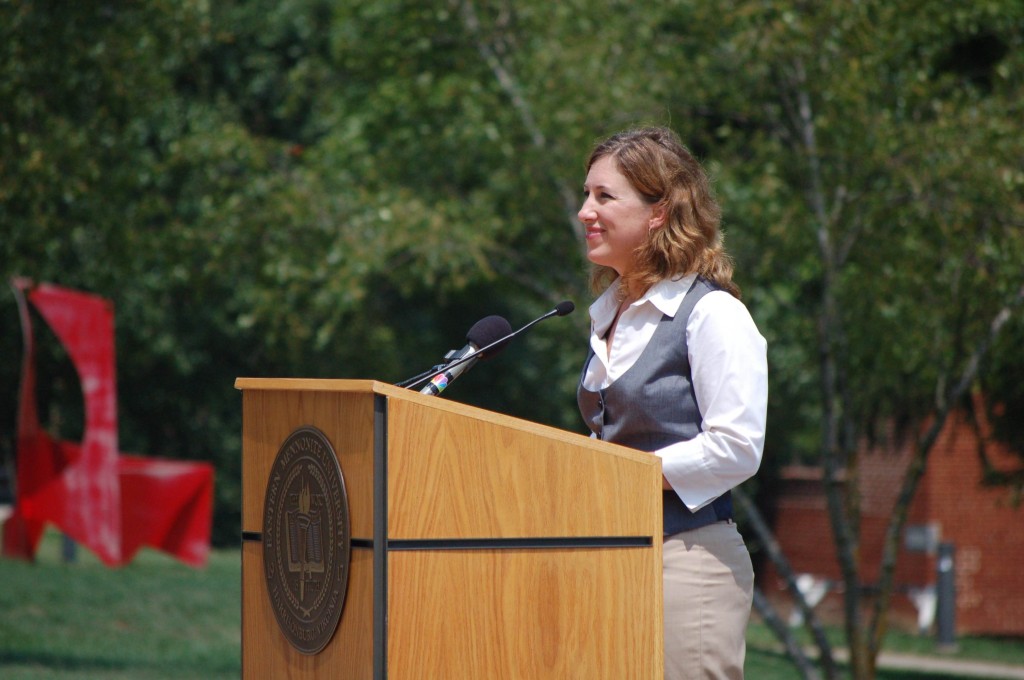In a Huffington Post commentary, EMU research professor Lisa Schirch praised the conflict transformation skills used spontaneously by the school staffer who, on Tuesday, talked a gunman into surrendering rather than shooting inside an elementary school in a suburb of Atlanta, Ga.
“Antoinette Tuff is a national hero,” wrote Schirch, who is affiliated with EMU’s Center for Justice and Peacebuilding. “Her story must be shared, passed onto future generations.”
Titling her commentary “She Didn’t Have a Gun… She Had MLK’s Dream,” Schirch pointed out that “learning to talk down a gunman is not some top-secret strategy. FBI agents learn how to talk down gunman. They use the same skills we teach in conflict transformation and peacebuilding. Listen, ask questions, share stories, show compassion.”
Schirch is also the founding director of the human security program under the Alliance for Peacebuilding based in Washington D.C.
A columnist in the Washington Post, Petula Dvorak, drew similar lessons from Antoinette Tuff’s sympathetic manner of speaking to the gunman, saying: “Are you listening to her, America? Her 911 call — listen to the whole thing; it’s riveting — is a portrait of poise, compassion and selflessness. She was exactly what America is forgetting to be.”

I have noticed that the race of Antoinette Huff is not mentioned in this article, nor is she honored by using her picture. I’ve noticed this to be the case in many of the news reports.
Should this be so? I think not.
Perhaps a headline such as ‘Meet the Black Woman Who Used Conflict Transformation Skills to Talk Down the White Male Atlanta School Shooter’ (along with Antoinette Huff’s picture) might be more appropriate.
I’ve changed the headline because perhaps mentioning race is the appropriate thing to do – especially when so many news reports sensationalize ‘black on white violence’ and distort reality in doing so. When we attempt to be ‘colorblind’ we do not acknowledge the experience and reality of ‘others’. When children grow up seeing their ‘race’ misrepresented (perhaps mainly portrayed in a negative fashion) in the media, they internalize a skewed view of reality. Yet in this article, ‘race’ was not omitted, the face of a white woman is prominently displayed. There was opportunity to to undo racist attitudes with this story, and the opportunity was not taken. I find this to be racist. Systemic racism, of this sort, is violent for sure. Please think about the messages children receive from such news reporting.
Regarding the posting a photo of Antoinette Huff, the EMU Communications Dept. is able to post photos pulled from its own university photography archives — as we did for this somewhat-dated photo of Lisa Schirch. We cannot, legally, grab news photos (or any others) off the Internet and re-use them without obtaining the permission of the photographer (or the entity) that holds the rights to that photo, which can be difficult and time-consuming to obtain.
I would have loved for this article to include a photo of Antoinette Tuff. Most of the official news stories did have a photo, so while it wasn’t mentioned in their articles, it was clear from the photo. I asked Huffington Post to include a photo of her – since they have access to photos to post that we do not legally have access to.
So I was not aware that there would not be a photo of her in the Huffington Post article.
I suggested that EMU could run a photo of the MLK memorial in Washington DC in their article, but again none were on file as noted by Bonnie.
I debated naming her as an African American woman in the article, but also anticipated criticism if I had done that. Journalists have gone back and forth on this issue and there has been extensive discussion with the African American community about when and how to mention the race of people in news articles. The journalistic rules that are generally followed are that people should be identified by race if and when race is important to the news article.
A few years ago on campus, I led a campus discussion on race about when and how to use racial references when referring to crime… to ensure that white perpetrators were also named as “white.”
In my last Huffington Post article, I noted that most school massacres are carried out by white men, and that it was important to recognize that white men more often than African American men felt entitled to carry out large scale atrocities.
I am not blind to race. But if every hero and every perpetrator were named by their race, I’m not sure this would make the news less racist. It is important to identify when and when not to identify.
I can see your point of view in this case. I agree that being blind to race is not what we are striving to achieve. I agree that white privilege is something blind to most white people. I agree that we don’t have enough positive media coverage of African American heroes. This is something I have worked to correct for many years.
I will remember your critique.
Dear Bonnie and Lisa,
Thanks so much for your responses. Race can be a difficult topic of conversation, for sure, and I appreciate you taking the time to explain to me your reasoning.
Nancy